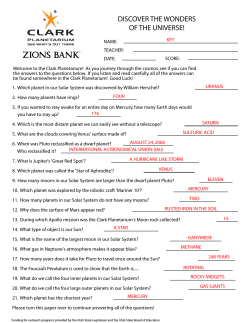
12.1 Homework sheet
EGYPTIAN AMERICAN INTERNATIONAL SCHOOL Elementary Science Department SEMESTER 2 GRADE 6 Name: Date: Class: Homework sheet 12.1 Vocabulary review Match each term in column B with its meaning in column A. Column A Column B ______1. A nearly round body, slightly smaller than a planet, whose orbit crosses the orbit of another body A. solar system ______2. A star and all the planets and other bodies that revolve B. planet around it. ______3. A large, round body that revolves around a star. C. asteroid ______4. A chunk of rock or iron less than 1,000 km (621 mi) in diameter D. dwarf planet that orbits the sun. ______5. A chunk of frozen gases, rock, ice, and dust orbiting the sun. E. comet SCIENCE CONCEPTS Write the letter of choice that best answers the question _____1. Josleen divided some of the planets into two main groups. The table below shows how she grouped them. Which two categories did Josleen most likely use to group the planets? planets and dwarf planets with moons and without moons orbit the sun and orbit other bodies Group 1 Group 2 Mercury Saturn Mars Uranus Venus Jupiter small diameters and large diameters _____2. It is difficult to see the surface of Venus through a telescope. Which feature of Venus best explains why its surface is difficult to observe from Earth? It is surrounded by thick clouds. It is covered completely by water. It is too far from Earth to be seen. It does not produce light of its own. Page 1 of 2 _____3. Why is the sun considered the center of the solar system? It is closer to Earth than other stars. The sun produces light and energy. The sun is the largest object that can be seen. Everything in the solar system revolves around the sun. _____4. Paul created a poster showing the solar system. Paul’s poster is shown below. Which of these details in Paul’s poster is most accurate? the order of the planets the number of moons shown the distances between the planets the sizes of the planets and the sun _____5. Ganymede is a moon of Jupiter. It is larger than Mercury and has a metallic core similar to Earth’s core. Which of these statements best explains why Ganymede is classified as a moon rather than a planet? It is too large to be called a planet. It orbits Jupiter instead of the sun. Its properties are different from Jupiter’s. It is farther from the sun than Mercury. APPLY INQUIRY AND REVIEW THE BIG IDEA Answer the following question: The planets are divided into rocky planets and gas giants. The gas giants are larger than the rocky planets but have lower densities. Explain how this is possible. _________________________________________________________________________________________ _________________________________________________________________________________________ _________________________________________________________________________________________ Page 2 of 2
© Copyright 2025












